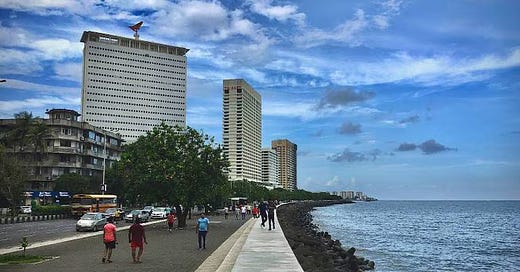Hello,
We’re all going gaga over India’s growth prospects. Everyone’s grandma is predicting 8% CAGR for 30 years, their dogs are talking about soft power and their babies are talking about civilizational resurgence.
That’s all fine and dandy- especially because such narratives help drive growth and attract investment.
As I wrote in my note to those building the country, we must be wary of smoking our stuff. The storytelling piece is going fine, but the hard work is ahead of us.
But even if our people (and our economy) work hard and do exceedingly well, the country cannot prosper unless the State hits the right notes instead of screwing shit up like Paresh Rawal in Hera Pheri.
Analyzing the history of our policy choices, one can quickly see that screwing up is the norm, rather than the exception- sometimes making one wonder if we’ve gotten so far because of our state or despite it.
As the famous quote goes, India disappoints both the optimists and pessimists.
Today’s piece is about understanding the first part of the equation- how the State’s policies stifle our progress. To dive deeper into this topic, I turned to the work of public policy writers Pranay Kotasthane and Raghu Jaitley.
Here are a few points on where the State messes up and what it can do instead:
Strong State Vs Big State: What the country needs is a strong state: one that’s capable of working on a few priority areas and executing them effectively. The State's resources are stretched because we’re a country of 140 Cr people with very low per capita income. So it must do what it can to deliver at least the basic things well: healthcare, education, law & order. However, instead of having a strong state, we have a big state: one that over-extends itself and gets into too many areas (like running businesses that ultimately lose lots of money) and ends up not getting the basics right. Countries like China, South Korea, and Japan first built a strong state (often through the monarchic route) and then developed a democracy- but we got things the other way around. Because we got democracy when we were very poor, the focus has always been on redistribution over the development of public goods. That’s why the State cannot engage in razor-sharp execution: doing just a few things and doing them well.
High ambition, low capacity: The State has very high ambitions, but the capacity to deliver them is very limited. We think that the govt is a bloated organisation and maybe if we clear the fat it can be more effective. But that’s not the case. Our public expenditure as a % of GDP is 27%, far behind Russia’s 36% and the US’ 38%. Even the number of govt employees per 1000 people is far behind some of these economies. To make things worse, top talent now avoids govt jobs like the plague- so we’re left with an overly zealous state that isn’t able to fix basic market failures in law & order, has stifling regulations, and offers poor educational services. Resolving the high ambition-low capacity paradox will be critical if the state has to deliver results.
Overreach: The govt loves setting price caps in an attempt to protect consumers, but these policies only make things worse. Putting an upper cap on rentals in Mumbai resulted in landlords ignoring the crap out of their properties because there was zero incentive to do any repair work if you weren’t going to be able to milk that real-estate cow. What we got was a bunch of buildings in SoBo in a state of utter ruin, looking worse than a bachelor who’s just fallen from the first floor of a shady bar after 13 shots of Vat 69. Or take their idea of slashing the price of stents by 85%. It only resulted in driving out high-quality players away from the Indian market and reducing the options available to consumers. Rich uncles can still get good stents from abroad, but the non-affluent are the ones who suffer because the market now only has products of questionable quality. A much better idea would be for the State to procure in bulk at lower costs via competitive bidding, as China frequently does.
Pro Market Vs Pro Business: Instead of promoting competition and the idea of doing business (pro-market), the state often creates policies that benefit a certain set of businesses (pro-business). This is a net negative- while it may make some incumbents bigger & richer, it deals a death blow to the idea of free and fair competition and prevents new players from coming up with innovative ideas and disrupting the market. A good example is the stifling of recurring payments- it was meant to curtail the activity of SaaS businesses who are increasingly taking away market share from legacy players. Another one is the specific incentive schemes that get doled out in a manner that only the largest and most deeply entrenched players can take advantage of.
Hyper Optimization: One reason many policies fail is that they try to achieve way too many objectives with one policy- like trying to kill 200 birds with one tiny-ass stone. Take the income tax policy- instead of just trying to collect taxes, it has a bunch of rebates and concessions to achieve many other objectives like trying to promote rural industry, encourage SEZs, etc- things that could have been achieved through other policies. This leads to lots of loopholes that fraudsters can take advantage of, while the rest of us spend hundreds of hours and many sleepless nights trying to navigate falling down the labyrinthine taxation hellhole.
These are but a few general ideas where the State falters and does a bad job of creating conditions for fast, widespread growth.
If India has to achieve its goals of being a developed nation by 2047, it’s not just down to the zealousness of its entrepreneurs and their craving for cash flow (which is already more abundant than one might think).
The outcome will depend heavily on whether the State can get its act together: to focus on the stuff that matters & execute well instead of spreading itself thin and turning everything into a sorry mess.
Thanks for tuning in! If you enjoyed this, don’t forget to read:






